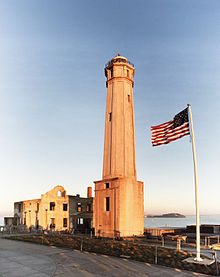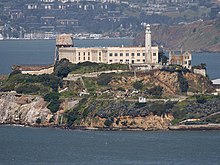Alcatraz Island Lighthouse
 Alcatraz Island Lighthouse | |
 | |
| Location | Alcatraz Island, San Francisco Bay, California, United States |
|---|---|
| Coordinates | 37°49′34.5″N 122°25′19.8″W / 37.826250°N 122.422167°W |
| Tower | |
| Constructed | 1854 (first) |
| Foundation | Masonry basement |
| Construction | Reinforced concrete |
| Automated | 1963 |
| Height | 84 feet (26 m) |
| Shape | Tapered octagonal tower with balcony and lantern |
| Markings | Unpainted tower, black lantern |
| Operator | Golden Gate National Recreation Area[1][2] |
| Heritage | National Register of Historic Places contributing property |
| Light | |
| First lit | 1909 (current) |
| Focal height | 214 feet (65 m) |
| Lens | Third order Fresnel lens (removed), DCB-24 aerobeacon (current) |
| Range | 22 nautical miles (41 km; 25 mi) |
| Characteristic | Fl W 5s. |
Alcatraz Island Lighthouse | |
| Part of | Alcatraz (ID76000209[3] ) |
| Designated CP | June 23, 1976 |
Alcatraz Island Lighthouse is a
History


Even though the
The

In the original order placed for supply of the equipment Argand lamps and parabolic reflectors had been specified as the Fresnel lens, created by
In 1909–12, the present cell house of Alcatraz was built. Since the new structure would interfere with the operation of the lighthouse, a taller 25.6 metres (84 ft), concrete tower was built south of the original lighthouse. The original lighthouse had been damaged during the great
Structural details


The first lighthouse was 50 feet (15 m) in height, and was based on a design that was typical of early "
The existing lighthouse is built to a height of 84 feet (26 m),[5] 214 feet (65 m) above sea level,[9] to the south of the original lighthouse. Its foundation is made of masonry while the octagonal pyramidal shaped tower is made of concrete. Initially, a third order Fresnel reflector was installed in 1854, and was replaced by a fourth order reflector in 1903. The foghorn bell was replaced by electronic Klaxon. Near the base of the tower was family accommodation also built to house three keepers and their families.[5][8] Similar "Cape-cod style" lighthouses, encircling the thick light brick tower, were built at Point Loma in San Diego, Point Pinos near Monterey and also on the Southeast Farallon Island about 30 miles (48 km) west of the San Francisco Strait.[7]

There was also a telephone installed, in the 1930, in the keepers quarters (moved to the hall later) known to and accessed only by the keepers. When the Federal Penitentiary was established on the island more telephones were installed and was made accessible to others also.[9]
The lighthouse was operated and maintained by the keepers whose responsibility included operation of fog signals found located on the northern and southern tips of the island. The prison guards facilitated the keepers to blow the fog horns as they were in advantageous position stationed on the elevated watch towers; the guards who were in position to see "a bank of fog started to roll through the Golden Gate", would inform notify the keepers so that the fog horns could be activated.[5]
The leading marks which guide the ships while entering the island are the lime point which is 2.5 miles (4.0 km) east and the black point which is lime 1 mile (1.6 km) north. The island itself is interspersed with several buildings and military towers. The highest point of the island is where the light house is located. Northwestern and southeastern tips of the island have small buildings which housed the fog signals (the electric horns were installed in small buildings known as "mid twentieth century foghorn shacks".[7]). The white light is shown by a grey tower flashes white that lasts for 0.5 seconds and eclipses' for 4.5 seconds and forming with the Fort Point light House a range for crossing the bar for the main ship. Fog signals are electric sirens, one on the southeast end sounding two blasts of 4 seconds duration, every 30 seconds while the one on the northwest end gives a single blast every 20 seconds of 5 seconds duration.[10]
Keepers
The three lighthouse keepers, known as "wickies", were dressed in prescribed formal uniforms which consisted of a "navy blue hat, sack coat, vest and trousers". Decorative buttons and insignia patches adorned their uniforms. The keepers worked on an eight-hour shift with the beacon lighted all through the year; during day time the lens was covered and protected from sun rays.[9]
The island's head lighthouse keepers included:[5]
- Michael Cassin (1853–1855)
- John Sloan (1855–1856)
- Underwhill Van Wagner (1856–1862)
- Hartford Joy (1862–1872)
- Amasa Bushnell (1872–1874)
- William W. Scott (1874–1875)
- John A. F. McFarland (1875–1878, 1882–1888)
- John T. Huie (1878–1882)
- Benjamin F. Leeds (1888–1905)
- Henry W. Young (1905–1909)
- James Anderson (1909 – at least 1912)
- Frederick Arthur Harrington (1919–1938) was the keeper of both the light houses and remained as keeper till his death in 1938.[9]
- Harry Davis (1938 – at least 1940)
- Edward H. Schneider (1950 – 1959)
- Norman Fornachon (at least 1962 – 1963)
Gallery
-
Hopi inmates and original light
-
Original lighthouse, c.1894
-
Top of light
-
Viewed from inland
-
Light on
-
Viewed from inland
-
Sunrise view of Lighthouse
See also
References
- ^ Rowlett, Russ. "Lighthouses of the United States: Northern California". The Lighthouse Directory. University of North Carolina at Chapel Hill. Retrieved June 9, 2016.
- ^ California Historic Light Station Information & Photography United States Coast Guard. Retrieved 9 June 2016
- ^ "NPS Focus". National Register of Historic Places. National Park Service. Archived from the original on July 25, 2008. Retrieved November 14, 2011.
- ^ a b "Alcatraz Island Lighthouse". Geographic Names Information System. United States Geological Survey, United States Department of the Interior. Retrieved September 10, 2012.
- ^ a b c d e f g h i j k "Alcatraz Island, CA". lighthousefriends.com. Retrieved September 10, 2012.
- ISBN 9780815313502.
- ^ ]
- ^ a b "Historic Light Station Information& Photography, California". Alcatraz Island Light. Retrieved September 10, 2012.
- ^ ISBN 9781468587531.
- ISBN 9781468587531.
External links
- U.S. Geological Survey Geographic Names Information System: Alcatraz Island Lighthouse
- "Historic Light Station Information and Photography: California". United States Coast Guard Historian's Office. Archived from the original on May 1, 2017.











